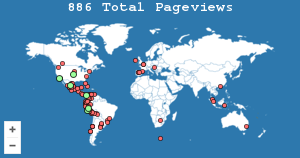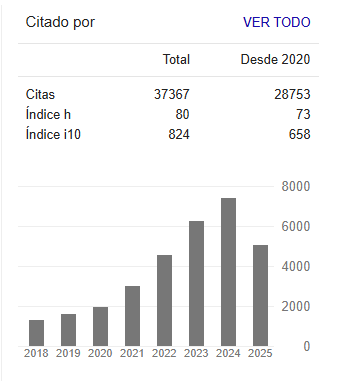Practice Configurations in Human Capital Management and Organizational Results
Abstract
Despite the growing importance that has been given to human capital as an object of research in the organizational field, at present there is still disagreement about the effects of the use of configurations of practices in its management on organizational results. For this reason, the main objective of this study is to analyze the effects of the adoption of practice configurations in human capital management on organizational results. For this purpose, a literature review is made that enables the formulation of hypotheses. Likewise, 550 self-administered questionnaires were distributed to a sample of 50 Colombian national companies, Colombian multinationals, North American multinationals and Spanish multinationals, all of them domiciled in Colombia. The data have been analyzed using the partial least squares analysis PLS-SEM or PLS path modeling. The results obtained suggest that the use of practice configurations in human capital management do not have positive effects on organizational results. It is concluded that for future studies, moderating contextual variables should be considered and said configurations of practices should be understood in the global framework of the human management system for each organization.
References
Barney, J. B. (1986). Strategic Factor Markets: Expectations, Luck, and Business Strategy. Management Science, 32(10), 1231-1241.
Barney, J. B. (1991). Firm Resources and Sustained Competitive Advantage. Journal of Management, 17(1), 99-120.
Becker, G. S. (1964). Human Capital: A Theoretical and Empirical Analysis, with Special Reference to Education. Nueva York, EEUU: Columbia University Press.
Black, S. E., & Lynch, L. M. (2004). What’s driving the new economy: The benefits of workplace innovation. The Economic Journal, 114(493), F97-F116.
Boon, C., Den Hartog, D. N., & Lepak, D. P. (2019). A systematic review of human resource management systems and their measurement. Journal of management, 45(6), 2498-2537.
Buller, P. F., & McEvoy, G. M. (2012). Strategy, human resource management and performance: Sharpening line of sight. Human resource management review, 22(1), 43-56.
Crandall, R.E., & Crandall, W.R. (2008). New Methods of Competing in the Global Marketplace. CRC Press, New York.
Delery, J., & Gupta, N. (2016). Prácticas de gestión de recursos humanos y efectividad organizacional: asuntos de ajuste interno. Revista de eficacia organizativa: personas y rendimiento, 3(2), 139-163.
Dyer, L. (1996). Specialized Supplier Networks as a Source of Competitive Advantage: Evidence from the Auto Industry. Strategic Management Journal, 17, 271-292.
Eisenhardt, K. (1988). Agency- and Institutional-Theory Explanations: The Case of Retail Sales Compensation. Academy of Management Journal, 31(3), 488-511.
Fayad, N. M., & Easa, N. F. (2020). Human resources management practices and employee engagement: known and unknown aspects in the literature. BAU Journal-Creative Sustainable Development, 2(1), 6.
Firth, L., Mellor, D. J., Moore, K. A., & Loquet, C. (2004). How can managers reduce employee intention to quit?. Journal of Managerial Psychology, 19(2), 170-187.
Gorman, C. A., Meriac, J. P., Roch, S. G., Ray, J. L., & Gamble, J. S. (2017). An exploratory study of current performance management practices: Human resource executives’ perspectives. International Journal of Selection and Assessment, 25(2), 193-202.
Hair, Jr., J. F., Hult, G. T. M., Ringle, C. M., & Sarstedt, M. (2014). A primer on partial least squares structural equation modelling (PLS-SEM). Los Ángeles: Sage Publications.
Huo, B., Ye, Y., Zhao, X., & Shou, Y. (2016) ‘The impact of human capital on supply chain integration and competitive performance. International Journal of Production Economics, 178(1), 132-143.
Kehinde, J. S. (2012). Talent Management: Effect on Organizational Performance. Journal of Management Resear HC, 4(2), 76-88.
Koch, M. J., & McGrath, R. G. (1996). Improving Labour Productivity: Human Resource Management Policies Do Matter. Strategic Management Journal, 17, 335–54.
Lepak, D. P., & Snell, S. A. (1999). The Human Resource Architecture: Toward a Theory of Human Capital Allocation and Development. Academy of Management Review, 24(1), 31-48.
Lepak, D. P., & Snell, S. A. (2002). Examining the Human Resource Architecture: The Relationship among Human Capital, Employment, and Human Resource Configurations. Journal of Management, 28(4), 517-543.
Lepak, D. P., Takeuchi, R. & Snell, S. A. (2003). Employment Flexibility and Firm Performance: Examining the Interaction Effects of Employment Mode, Environmental Dynamism, and Technological Intensity. Journal of Management, 29(5), 681-703.
Liu, Y., Combs, J. G., Ketchen Jr, D. J., & Ireland, R. D. (2007). The value of human resource management for organizational performance. Business horizons, 50(6), 503-511.
Mahoney, T. A. (1989). Multiple Pay Contingencies: Strategic Design of Compensation. Human Resource Management, 28(3), 337–347.
Melián-González, S., & Verano-Tacoronte, D. (2008). Estilos de Dirección de RRHH dentro de las Empresas. Cuadernos de Economía y Dirección de Empresas, 11(36), 151-177.
Miles, R. E., & Snow, C. C. (1984). Designing Strategic Human Resource Systems. Organizational Dynamics, 13(1), 36-52.
Mozo, F., & Pérez, M. P. (٢٠٠١). Una Perspectiva Dual para la Gestión de los Recursos Humanos: ¿Optimizar Recursos o Reducir Costes Contractuales? Dirección y Organización, 25, 69-79.
Nonaka, I., & Takeuchi, H. (1995). The Knowledge-Creating Company. How Japanese Companies Create the Dynamics of Innovation. New York: Oxford University Press.
Pfeffer, J. (1994). Competitive Advantage through People: Unleashing the Power of the Work Force. Boston: Harvard Business School Press.
Pham, H. (2020). Impact of human resource management practices on enterprises’ competitive advantages and business performance: Evidence from telecommunication industry. Management Science Letters, 10(4), 721-732.
Quinn, J. B. (1992). Intelligent enterprise. New York: Free Press.
Quinn, J. B., Anderson, P., & Finkelstein, S. (1996). Managing Professional Intellect: Making the Most of the Best. Harvard Business Review, 74(2), 71–80.
Rousseau, D. M., & Parks, J. M. (1993). The contracts of individuals and organizations. En L. L. Cummings & B. M. Staw (Eds.), Research in organizational behaviour (pp. 1-43). Connecticut: Greenwich, JAI Press.
Schultz, T. W. (1961). Investment in Human Capital. American Economic Review, 51(1), 1-17.
Siong, Z. M. B, Mellor, D., Moore, K. A., & Firth, L. (2006). Predicting Intention to Quit in the Call Center Industry: Does the Retail Model Fit? Journal of Managerial Psychology, 21(3), 231 243.
Snell, S. A., & Dean, J. W. Jr. (1994). Strategic Compensation for Integrated Manufacturing: The Moderating Effects of Job and Organizational Inertia. Academy of Management Journal, 37(5), 1109–1140.
Tsang, M.C., Rumberger, R.W., & Levin, H.M. (1991). The Impact of Surplus Schooling on Worker Productivity. Industrial Relations, 30(2), 209-228.
Walsh, C. (1994). Ratios Clave para la Dirección de las Empresas. London: Pitman.
Westwick, C. A. (1997). Manual para la Aplicación de Ratios de Gestión. Bilbao: Ediciones Deusto.
Williamson, O. E. (1975). Markets and hierarchies: Analysis and antitrust implications. New York: Free Press.
Williamson, O. E. (1981). The Economics of Organization: The Transaction Cost Approach. American Journal of Sociology, 87(3), 548-577.
Wuen, C. H., Ibrahim, F., & Ringim, K. J. (2020). The Impact of Human Resource Management Practices on SMEs Performance: An Exploratory Study in Brunei Darussalam. International Journal of Asian Business and Information Management (IJABIM), 11(2), 68-87.








.png)






























